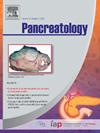急性胰腺炎后胰腺外分泌功能的改变
IF 2.8
2区 医学
Q2 GASTROENTEROLOGY & HEPATOLOGY
引用次数: 0
摘要
胰腺外分泌功能障碍(EPD)是胰腺疾病的一种吸收不良并发症,可导致从胀气到腹泻等一系列症状,并导致体重减轻和代谢性骨病。越来越多的人认识到,它发生在急性胰腺炎(AP)之后,包括轻度胰腺炎。急性胰腺炎后发生 EPD 的风险受一系列因素的影响,包括急性胰腺炎时尖锐湿疣细胞的破坏和炎症程度,以及急性胰腺炎后持续的结构紊乱。在本文中,我们将讨论 AP 后 EPD 的流行病学、病理生理学和临床管理,同时强调关键的知识缺口。本文章由计算机程序翻译,如有差异,请以英文原文为准。
Alterations in exocrine pancreatic function after acute pancreatitis
Exocrine pancreatic dysfunction (EPD) is a malabsorptive complication of pancreatic disorders that can lead to a host of symptoms ranging from flatulence to diarrhea and contribute to weight loss and metabolic bone disease. It is increasingly recognized to occur after acute pancreatitis (AP), including episodes with mild severity. The risk of developing EPD after AP is influenced by a range of factors, including the degree of acinar cell destruction and inflammation during AP, and persistent structural derangements following AP. In this article, we discuss the epidemiology, pathophysiology, and clinical management of EPD after AP while highlighting key knowledge gaps.
求助全文
通过发布文献求助,成功后即可免费获取论文全文。
去求助
来源期刊

Pancreatology
医学-胃肠肝病学
CiteScore
7.20
自引率
5.60%
发文量
194
审稿时长
44 days
期刊介绍:
Pancreatology is the official journal of the International Association of Pancreatology (IAP), the European Pancreatic Club (EPC) and several national societies and study groups around the world. Dedicated to the understanding and treatment of exocrine as well as endocrine pancreatic disease, this multidisciplinary periodical publishes original basic, translational and clinical pancreatic research from a range of fields including gastroenterology, oncology, surgery, pharmacology, cellular and molecular biology as well as endocrinology, immunology and epidemiology. Readers can expect to gain new insights into pancreatic physiology and into the pathogenesis, diagnosis, therapeutic approaches and prognosis of pancreatic diseases. The journal features original articles, case reports, consensus guidelines and topical, cutting edge reviews, thus representing a source of valuable, novel information for clinical and basic researchers alike.
 求助内容:
求助内容: 应助结果提醒方式:
应助结果提醒方式:


